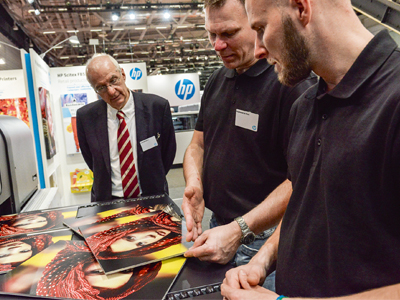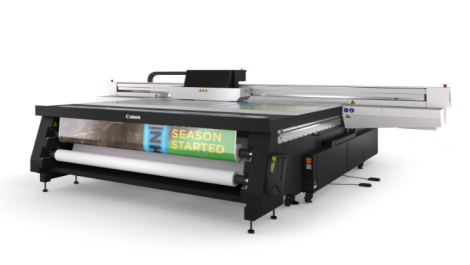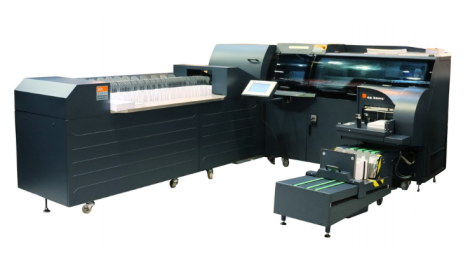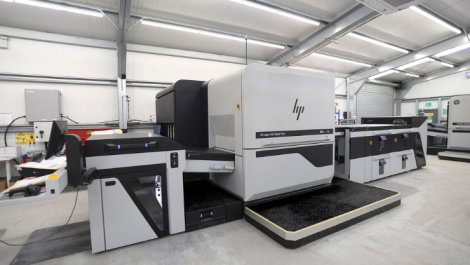Another FESPA show has passed. Digital Printer visited the Koelnmesse in Cologne to catch up on the latest in wide format digital printing.
On the first day of FESPA 2015, during an afternoon panel debate the predicament of the average visitor was summed up by Inca Digital chief executive John Mills: ‘The challenge for people walking around the show is it’s very difficult to tell the differences between the machines. The quality will all look great. Everyone has a brochure and the throughput on those is never what you get in reality. Customers think: how do they differ? We will see new ink from Durst and that’s going to be something that does differentiate.’
Mr Mills’ words came immediately prior to Durst’s press conference in fact, when it formally announced its new Durst Water Technology, an aqueous ink containing what it called ‘reactive molecules’ that give it greater adhesion, durability and resistance performance. It is therefore a mid-point or hybrid of sorts between water-based inks which are more eco-friendly and UV-curing inks which open up a wider range of applications. It is Durst’s long term strategy, said its chief executive Christoph Gamper, to develop an alternative to UV printing. ‘We all went from solvent to UV and now it’s time to move from UV to water,’ he added.
To help printers along the way, the company has developed a new machine that is designed specifically to use the Durst Water Technology. This is the Rho WT 250 HS, which uses a 10pl drop size to hit print resolutions of up to 1000 dpi. Infra-red is used for pinning and post-curing of the image.
HP also called a press conference on the first day of FESPA to announce new additions to its wide format Latex range of printers, more than 26,000 of which have been installed since the technology’s launch in 2008. The new models are the Latex 3500 and Latex 3100. The former has a 10 litre ink supply, heavy duty roll handling, in-line slitters to reduce finishing bottlenecks, and dual-roll split spindles for easier handling of oversized rolls. It is aimed at customers with one specific application that they want to maximise production efficiency on. The Latex 3100 is more suited to flexibility and is aimed at those customers that need to print multiple application types. It replaces the Latex 3000.
Chatham large format printer PressOn has been using the Latex 3500 and on a video clip managing director Andy Wilson said the firm had been ‘pushing the boundaries of what you can put through the 3500, running 250 metre rolls 2-up at a time’. He added: ‘PressOn strives for efficiency and any efficiency you can show to clients gives you a competitive edge. The Latex 3500 fits into that philosophy.’
EFI introduced the EFI Vutek HSr press at FESPA, its fastest production-class roll-to-roll product. The new LED/UV Pin & Cure imaging press is a 3.2 metre high-speed roll-to-roll printer that targets the replacement of older solvent printers for the high-volume production of vehicle wraps, lorry sides, banners, posters and more. It has six colours plus white ink with multi-layer print capability for the production of day/night backlit graphics. The HSr press also features EFI 3M SuperFlex HSr Ink, backed up by the 3M MCS Warranty.
The company had a new ink running on its Vutek GS5500 too. The co-branded EFI and 3M SuperRange Inks are available for the Vutek GSlxr series printers in six- and eight-colour plus white configurations. The inks offer a hard surface cure, a wide colour gamut and excellent adhesion properties, making them the ideal choice for a wide range of materials and printing applications, according to EFI.
Over on the Fujifilm stand, the launch of the Inca Onset R40LT wide-format, flatbed UV printer was taking place. This is a Light version of the Onset R40, with certain advanced features such as automatic media handling and software functionality being taken away to provide a mid-range machine that is more affordable.
It can be upgraded in the field however, so customers can progress from a four-colour, 265 square metres per hour device, up to an eight-colour fully specified device, as their business grows. The 3.14 x 1.6 metre full-width array flatbed printer can print on substrates up to 50 mm (two inches) thick.
Much to see
There was a good deal more new printing technology being talked about and shown for the first time at FESPA, with Agfa, Gandy, Inktec, Screen, Seiko and SwissQprint all having new or improved printing systems on display, while the burgeoning dye sublimation and textile printing areas were also well represented with fresh systems, through Epson, Kornit Digital, Mimaki, Mutoh and Sawgrass.
Agfa gave European debuts to the Jeti Mira and Jeti Tauro. The Jeti Mira is a flatbed printer with a dockable roll-to-roll option for those that want to print on flexible media. It can handle media up to 2.7 x 1.6 metres, in thicknesses up to 50 mm. The Jeti Tauro however is distinctly a hybrid flatbed/roll-to-roll UV inkjet device which can handle flexible media up to 2.5 metres wide, and rigid media up to 2.5 x 4 metres in size and 50 mm thick. Both have optional white ink configurations.
Canadian manufacturer Gandy Digital announced the Gladi8tor UV flatbed inkjet printer. It has an inline ‘8 Blade’ printhead configuration, enabling a double CMYK set-up to deliver twice the speed (up to 240 square metres per hour) of its own Domin8tor and Pred8tor models. Gandy claims that this makes the printer the most productive solution in its class.
Inktec launched a new 5-metre wide UV roll-to-roll printer – the Jetrix RX5000 – which follows its recent first superwide launch – the 3.2 metre Jetrix RX3200. These are both based on the same Konica Minolta 14pl printheads, available in four or eight colour configurations.
Following its starring role as Digital Printer’s Centrefold last month, a roll-to-roll system for Screen’s Truepress Jet W3200UV flatbed made a world debut at FESPA, while Seiko’s third generation ColorPainter H series was on show: the H3-104 having a 104-inch maximum media size and odourless eco-sol inks; image quality has been improved through the software, and the system will be available in the Autumn. SwissQprint launched second versions of its Oryx and Impala UV flatbed printers, featuring 25% larger bed sizes than their predecessors. Oryx is the entry level device (print speed up to 65 square metres per hour), while Impala 2 can reach 180 square metres per hour.
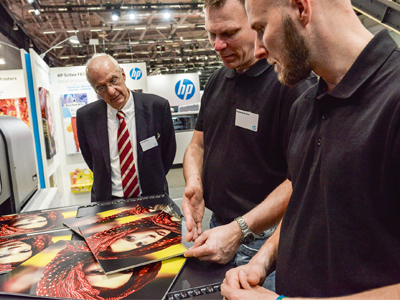
FESPA fashion
Printing onto garments and other textiles, whether directly or via sublimation, is a sector of the market that it experiencing a good deal of growth, and some of the exhibitors at FESPA seem keen to feed that growth with new printing systems.
Epson announced a new fabric dye sublimation printer and a new ink at the show. The SureColor SC-F9200 is a 64-inch wide system that prints at up to 100 square metres per hour, considerably quicker than the SC-F7100, its predecessor as Epson’s flagship printer for this market. It has two print heads and two CMYK configuration inks. The K in the CMYK is HDK Black Ink, a high density ink developed for deep, neutral blacks and dense shadows in textile printing.
Kornit Digital’s Allegro direct to garment printing system was shown in upgraded form,with new print heads that have an ink recirculation system, which keeps ink circulating constantly even when the printer is not printing. This improves reliability and print quality. It also has an improved web transport system which simplifies working with light fabrics in particular.
Mimaki unveiled its own dye sublimation print, the TS300P-1800. This is a 1.8 metre (approx. 70 inch) wide printer available in four or six colour configurations, capable of a top speed of 115 square metres per hour (one-pass draft mode) and 38 square metres per hour (four-pass standard mode).
There were three new printers from Mutoh: a desktop direct to garment printer (ValueJet 405GT); a dye sublimation printer (ValueJet 1938WX); and a sign and display printer (ValueJet 1628X). ValueJet 405GT is Mutoh’s first such device and has five colours (CMYK + White) to print directly onto t-shirts and many other garment types. ValueJet 1938WX is a 75-inch wide printer suitable for producing home textiles, deco fabrics, fashion, sportswear and soft signage. The 64-inch ValueJet 1628X has white and metallic ink capabilities and has been developed for long term outdoor applications with premium finishes.
Sawgrass unveiled the newest addition to its Virtuoso line of fully integrated dye sublimation systems. The new 24-inch eight-colour Virtuoso is the first printer of this size to be manufactured specifically for sublimation printing. It is a combination of Mutoh’s ValueJet printer technology and Sawgrass’ SubliJet-HD sublimation ink.
While software was not really to the fore at FESPA, there was a preview of the new version of Onyx’s RIP software. Version12 is to be launched this summer and according to the developer ‘enhances software responsiveness and allows print service providers to expand their applications with brand new finishing tools’. Easier automation and a modified user interface to simplify job preparation are also included.
